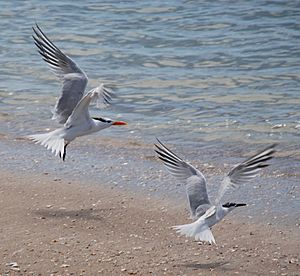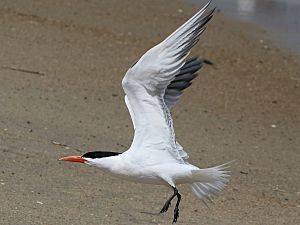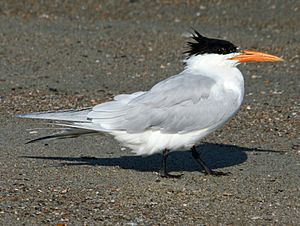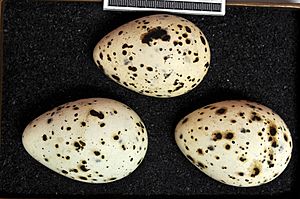Royal tern facts for kids
Quick facts for kids Royal tern |
|
|---|---|
 |
|
| Winter plumage | |
| Conservation status | |
| Scientific classification | |
| Genus: |
Thalasseus
|
| Species: |
maximus
|
 |
|
| Synonyms | |
|
Sterna maxima |
|
The royal tern (Thalasseus maximus) is a type of tern bird. It belongs to the family Laridae, which includes gulls. This bird has two main types, called subspecies. One type, T. m. maximus, lives along the Atlantic and Pacific coasts of North and South America.
Royal terns have a bright red-orange beak. During the time they lay eggs (breeding season), they have a black cap on their head. In winter, this black cap becomes patchy. You can find royal terns in Europe, the Americas, and the Caribbean islands. They always live near the coast and prefer salty water. They like to find food close to beaches or in calm bays. The good news is that the royal tern is not in danger of disappearing.
Contents
About the Royal Tern's Name
The royal tern was first described in 1781 by a French scientist named Georges-Louis Leclerc, Comte de Buffon. He wrote about a bird found in Cayenne, French Guiana. Another scientist, Pieter Boddaert, later gave it the scientific name Sterna maxima in 1783.
Today, the royal tern is placed in the genus Thalasseus. This name comes from an Ancient Greek word, thálassa, which means "sea". The word maximus is Latin for "greatest". So, its name means "greatest sea bird".
Royal terns are birds that belong to the group called Aves. They are also part of the order Charadriiformes. This group mainly includes seabirds that are small to medium-sized. Royal terns are in the family Sternidae because they have white feathers, a black cap, a long beak, and webbed feet. Their bodies are also more streamlined than those of gulls.
Scientists used to debate if the correct name was Thalasseus maximus or Sterna maxima. Now, it is officially known as Thalasseus maximus. This places it with six other seabirds in the tern family.
What Does a Royal Tern Look Like?
The royal tern is a large tern. Only the Caspian tern is bigger. It has a bright orange-red beak. Its upper body is pale grey, and its belly is white. Its legs are black. In winter, the black cap on its head becomes patchy.
Young royal terns look similar to adults that are not breeding. But young birds have black spots on their wings. Their beaks are also more yellow. An adult royal tern has a wingspan of about 130 cm (51 in). This means their wings stretch about 1.3 meters wide. Their length is about 45–50 cm (18–20 in). They usually weigh between 350–450 g (12–16 oz).
The sounds royal terns make are usually short, clear calls. Some calls sound like kree or tsirr. They also have a longer, more musical whistle.
Where Do Royal Terns Live?

In the Americas, royal terns on the east coast breed from April to July. They can be found as far north as Virginia. Sometimes, they even go to Long Island, New York. Their breeding area goes south to Texas. In winter, they fly from North Carolina south to Panama and the Guianas. They also visit the Caribbean islands.
On the west coast of the Americas, royal terns breed from California to Mexico. They spend winter from California south to Peru. Birds from America fly south to Peru and Argentina for the winter. This helps them escape the cold weather. Some African birds can fly as far north as Spain. Sometimes, these terns even visit Western Europe. These birds are likely from the American groups.
Royal Tern Behavior
How Royal Terns Find Food
Royal terns usually look for food in calm water. This includes places like estuaries, mangroves, and lagoons. Less often, they hunt for fish in open water. They usually stay within 100 metres (110 yards) of the shore. Royal terns mainly eat in salt water. They rarely eat in fresh water. They fly long distances from their nesting areas to find food.
Royal terns catch food by diving into the water from about 30 feet (9.1 metres) high. They usually hunt alone or in small groups. But sometimes, they hunt in large groups. This happens when they find big schools of fish.
Their main food is small fish like anchovies and weakfish. But they also eat insects, shrimp, and crabs. They eat small crabs, like young blue crabs, that swim near the water's surface. When hunting crabs, they do not dive deep. Instead, they make short, shallow dives. This helps them stay hidden from their prey. They use this same trick when hunting flying fish.
Royal Tern Life Cycle
Royal terns build their nests on island beaches. They also use isolated beaches where there are not many predators. They lay one or two eggs. They usually make a small hole in the ground, called a scrape, for their eggs. Sometimes, they lay eggs directly on the ground.
The eggs hatch after 25 to 30 days. After hatching, the chicks stay in the scrape for about a week. About two weeks later, the chicks gather into groups. These groups are called a crèche. When chicks are in a crèche, their parents feed them. Parents recognize their own chicks by their voice and how they look. Chicks in a crèche usually walk freely around the nesting area. In a big colony, there can be thousands of chicks in a crèche.
When the chicks are about a month old, they fledge. This means they start to fly. Royal terns become adults around 4 years old. Then, they build their own nests and have their own chicks. Like other white terns, they protect their nests and young very fiercely. Royal terns and Cayenne terns often nest and breed together in Argentina and Brazil.
Dangers to Royal Terns
Adult royal terns have few enemies. But before the eggs hatch, or when they are chicks, royal terns face dangers. These include humans, other animals, and the tides. Humans can harm terns by fishing or disturbing their nesting sites. Fishing nets can catch a tern while it is diving. This can stop it from eating or cause it to drown.
Animals like foxes, raccoons, and large gulls eat tern chicks and eggs. High tides can also affect tern nesting sites. If a group of terns nests too close to the high tide line, a very high tide can flood the area. This can kill the chicks and make unhatched eggs unable to develop.
Protecting Royal Terns
The royal tern is part of an important agreement. It is called the Agreement on the Conservation of African-Eurasian Migratory Water Birds (AEWA). This agreement helps protect 255 species of birds. These birds need wetlands for part of their lives. The AEWA covers birds from 64 countries in Africa and Eurasia.
There are not many other special efforts to protect royal terns. This is because their status is "least concern." This means scientists are not very worried about them becoming extinct. The reason is that their population has not dropped enough to be considered threatened or endangered.
See also
 In Spanish: Charrán real para niños
In Spanish: Charrán real para niños






